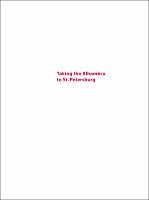Taking the Alhambra to St. Petersburg
Neo-Moorish Russian Architecture and Interiors 1830–1917
Author(s)
Kaufmann, Katrin
Collection
Swiss National Science Foundation (SNF)Language
EnglishAbstract
Little is known of Russian architects’ in-depth engagement with Ibero-Islamic architecture, especially the medieval Nasrid palaces of the Alhambra in Granada, in the so-called Moorish Revival. This study, rich in material, analyzes 19th-century Orientalizing buildings and interiors in St. Petersburg and traces the routes by which the formal vocabulary of the Alhambra reached Russia from Spain. Incorporating essential aspects of Russian cultural history and 19th-century European notions of the Orient, it shows that Russian architects and the Imperial Academy of Arts were among the pioneers of the Moorish Revival. The first examination of St. Petersburg’s Orientalizing architecture in a pan-European context Russian architects as pioneers of the Moorish Revival ; Little is known of Russian architects’ in-depth engagement with Ibero-Islamic architecture, especially the medieval Nasrid palaces of the Alhambra in Granada, in the so-called Moorish Revival. This study, rich in material, analyzes 19th-century Orientalizing buildings and interiors in St. Petersburg and traces the routes by which the formal vocabulary of the Alhambra reached Russia from Spain. Incorporating essential aspects of Russian cultural history and 19th-century European notions of the Orient, it shows that Russian architects and the Imperial Academy of Arts were among the pioneers of the Moorish Revival. The first examination of St. Petersburg’s Orientalizing architecture in a pan-European context Russian architects as pioneers of the Moorish Revival ; Ein wenig bekanntes Phänomen innerhalb des sogenannten Maurischen Revivals ist die intensive Auseinandersetzung russischer Architekten mit der ibero-islamischen Architektur, insbesondere mit den mittelalterlichen Nasridenpalästen der Alhambra in Granada. Die materialreiche Studie analysiert orientalisierende Bauwerke und Interieurs des 19. Jahrhunderts in St. Petersburg und zeichnet die Transferwege nach, über die das Formenvokabular der Alhambra von Spanien nach Russland gelangte. Sie bezieht wesentliche Aspekte der russischen Kulturgeschichte und der europäischen Orient-Vorstellungen des 19. Jahrhunderts mit ein und zeigt, dass russische Architekten und die Kaiserliche Akademie der Künste zu den Pionieren des Maurischen Revivals gehörten. Erstmalige Betrachtung der orientalisierenden Architektur St. Petersburgs im gesamteuropäischen Kontext Russische Architekten als Pioniere des Maurischen Revivals
Keywords
Architektur; 19. Jahrhundert; Alhambra; Andalusien; Spanien; Orientalismus; St. Petersburg; Russland; Rezeption; architecture; 19th century; Granada; Andalusia; Spain; Orientalism; RussiaDOI
10.1515/9783111141374ISBN
9783111141374, 9783110710656, 9783111141374Publisher
De GruyterPublisher website
https://www.degruyter.com/Publication date and place
Berlin/Boston, 2023Imprint
De GruyterClassification
The arts: general topics
History of art
19th century, c 1800 to c 1899
Decorative arts
History of architecture


 Download
Download Web Shop
Web Shop